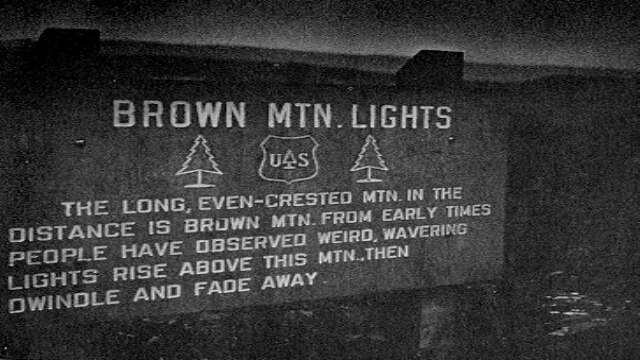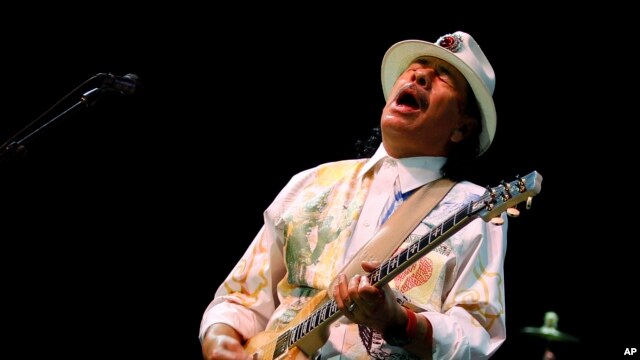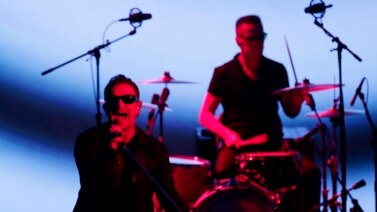
Welcome to American Mosaic from VOA Learning English.
I’m Faith Lapidus.
On the show today, we tell all about this year’s Kennedy Center honorees. And we play music by some of the honored artists.
But first, we look into the mystery of strange lights that sometimes glow above a mountain in North Carolina.
Brown Mountain Lights
For almost one hundred years, people have looked up at the night sky over a certain part of North Carolina and wondered: what is that? They see sometimes see balls of light high above them. So far there is no clear explanation of where these lights come from or what they are made of. Jim Tedder has our story.
The mystery began in September of nineteen-thirteen. A man was fishing at night in the Blue Ridge Mountains of North Carolina. There was no sound, but suddenly unusual lights began to appear over Brown Mountain. The fisherman said they were red and round, like a ball. They were unlike anything he had seen before. They came back night after night.
He told some friends about what he had seen. The Charlotte Daily Observer newspaper wrote about the story. A worker for the United States Geological Survey visited the area to investigate. He decided that what the fisherman and others had seen was nothing more than lights from a train. End of story.
But the lights continued to appear. Some people said September, October, and November were the best months to see them. Nine years later, a Geological Survey team came back to the area to conduct a larger investigation.

As before, they decided there was no mystery. They said witnesses were seeing train lights, camp fires, or automobile lights. In nineteen sixteen a large flood swept through the area. Electrical power was lost. Trains could not run. Roads and bridges were washed away. But the Brown Mountain lights continued to appear.
If there are unusual lights around Brown Mountain, what could they be? Throughout the southern United States, people have spoken of seeing a “Jack o Lantern” or “Will of the Wisp”, floating in the night sky. Scientists say these sightings are often balls of swamp gas. As plants die in low, wet, swampy areas, they release gas that glows.
Another theory says the lights are caused by electrically charged plasma, a type of lightning that floats like a ball. Others say quartz rocks in the ground create a “piezoelectric” effect when the earth moves. Still others suggest that the lights are reflections from far away cars and homes.
But the people who love a good mystery say the Brown Mountain lights are the spirits of the Cherokee and Catawba Indians who lived in the area many years ago. Some think unidentified flying objects and space aliens are involved. But when the fishing rods are cleaned and stored for the night, and the guitars, violins, and banjos are tuned, the mountain people of western North Carolina sing about a lonely old slave who came back from the grave searching for his master, night after night after night.
Kennedy Center Honorees Announced
Each year in Washington, the John F. Kennedy Center for the Performing Arts honors performers for a lifetime of work. The ceremony is held at the Kennedy Center in December. This week, officials announced the names of the artists who will receive the honors for 2013.
They include two rock and rollers, a jazz composer and an opera singer. But we will start with someone who seems to do everything: Shirley MacLaine.
Shirley MacLaine has performed on stage and screen during her 60 year career. She is an actor, dancer, writer and political activist.
MacLaine has been nominated for five best actress Academy Awards. She won the Oscar for playing Aurora Greenway in the 1983 film, “Terms of Endearment.” The character is controlling and judgmental but also very funny.

Here, Aurora Greenway is having a dinner party when her daughter Emma announces that she and her husband Flap are expecting a baby.
EMMA: “I got some good news.”
AURORA: “What’s that?”
EMMA: “I’m unofficially pregnant. I mean we haven’t gotten the test back yet but you know me I’m never late.”
AURORA: “Well. I don’t understand.”
EMMA: “Um. Hmm, if you’re not happy for me…. I’m gonna get so mad, if you’re not happy.”
AURORA: “Why should I… why should I be happy about being a grandmother?”
FLAP: “Does this mean you won’t be knitting the baby any booties?”
(MUSIC)
Carlos Santana is another honoree. The Mexican-American guitarist and composer performed at Woodstock in 1969. He continues to lead his band Santana to this day. Santana has 10 Grammys and three Latin Grammys among his many music awards. The 66-year-old is considered one of the greatest guitarists in the world.
Carlos Santana is credited with developing a whole new style of music. He mixes jazz, rock, blues and Latin influences to create a sound that is smooth and danceable.
Here he performs the Grammy-winning song “Smooth” from his 1999 Grammy-winning album “Supernatural.”

The Kennedy Center is also honoring pop star Billy Joel this year. Joel is sometimes thought of as the American version of Elton John. They both play piano and have a history of writing hit song after hit song. And both are praised by serious music critics.
At 64 years old, Billy Joel has won six Grammys and been nominated for 23. He is one of the world’s biggest-selling musicians and a member of the Rock and Roll Hall of Fame.
Billy Joel is a native of the Bronx area of New York City. Here he performs, “Piano Man,” a hit from early in his career.
(MUSIC)
The Kennedy Center is also honoring another New York City native, classical soprano Martina Arroyo. Arroyo was born and raised in the Harlem area in 1937. She began her career in opera in the 1960s. The African-American-Hispanic singer was entering the industry when few blacks performed at major opera houses. She helped break down the racial barriers in the opera world.
Martina Arroyo starred in many shows over the next 20 years at all the famous opera houses including La Scala in Milan, Italy, the Paris Opera in France and the Metropolitan Opera in New York City.
Here she sings as Aida, from Guiseppe Verdi’s opera of the same name.
The final Kennedy Center honoree is jazz great Herbie Hancock. The 73-year-old pianist, composer and bandleader modernized jazz with his use of electronic instruments.
Herbie Hancock was born in Chicago, Illinois. He began playing classical piano very young. At the age of eleven, he played with the Chicago Orchestra. Several years later he taught himself how to play jazz, just by listening to the music.

Hancock has won fourteen Grammys and an Oscar for his work. He has worked on many projects with artists from different music styles. The Kennedy Center calls Herbie Hancock “a true living treasure of American culture.”
I’m Faith Lapidus. Our program was written by Jim Tedder and Caty Weaver, who was also the producer.
Do you have a question about American life, people or places? Send an e-mail to learningenglish@voanews.com. We might answer your question in a future show.
Join us again next week for music and more on American Mosaic from VOA Learning English.



